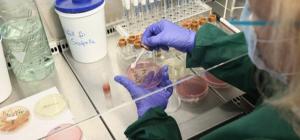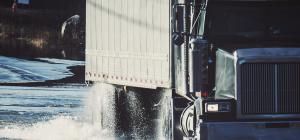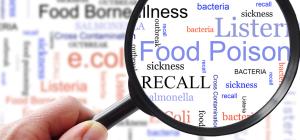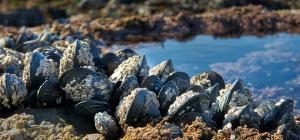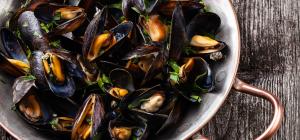
Pulsed electric fields: A potential alternative technology for parasite control in fish

Key Messages |
|
Introduction
Around the world, many cultures use different types of raw seafood such as fish, oysters, scallops, and other types of molluscan shellfish in various dishes, such as sushi, crudo, carpaccio, and ceviche.1 However, fish and molluscan shellfish can harbour bacteria such as Vibrio spp., Salmonella spp., Shigella spp., and Campylobacter jejuni, as well as viruses such as hepatitis A virus and norovirus, which can cause foodborne illnesses.2 Fish and shellfish may also be subjected to process-related hazards such as Clostridium botulinum, Staphylococcus aureus, Listeria monocytogenes, Escherichia coli., and other pathogenic bacteria as a result of harvest water contamination, poor sanitary and temperature control practices on fishing vessels, and poor aquaculture practices.2
Parasites such as nematodes or roundworms (Anisakis spp., Pseudoterranova spp., Eustrongylides spp., and Gnathostoma spp.), cestodes or tapeworms (Diphyllobothrium spp.), and trematodes or flukes (Chlonorchis sinensis (C. sinensis), Opisthorchis spp., Heterophyes spp., Metagonimus spp., Nanophyetes salmincola, and Paragonimus spp.) can also be found in fish and shellfish.2 If accidentally ingested by humans, these parasites typically cause mild-to-moderate illness with symptoms such as abdominal pain, abdominal swelling, nausea, vomiting, and diarrhea, but may also cause severe issues such as intestinal penetration and damage to vital organs.2 Fish can become infected with parasites when they ingest infected crustaceans and other small organisms (see Figure 1 for the life cycle of Anisakis spp.).3,4 Therefore, all wild-caught fish are susceptible to parasite infection as no fishing grounds are considered to be free of parasites.5 In farmed or aquaculture salmon, Good Aquaculture Practices (GAPs) can reduce the risk of parasitic hazards by using floating cages or onshore tanks and pelletized foods that are free of live parasites.5,6
Figure 1. Life cycle of Anisakis spp.7

Seafood-borne parasitic infections have been reported in both Canada and the United States in the past with sufficient frequency to warrant preventive control measures to be implemented.2,8 Data obtained from the Publicly Available International Foodborne Outbreak Database, maintained by the Public Health Agency of Canada, recorded 1,060 cases of fish-related parasite infections found in the literature worldwide between 1988 and 2022.9 In Japan, Anisakis infection is the leading cause of foodborne illness due to the popularity of raw seafood. In 2020, 397 Anisakis infection patients were reported to the Ministry of Health, Labour and Welfare of Japan, but data from medical institutions estimated the annual number of Anisakis infections at 7,000 cases.10 Spain has the second highest number of incidents of anisakiasis-related hospitalizations after Japan at 130 patients annually.11 Another report estimated that as of 2010, approximately 20,000 cases of Anisakis infection were reported worldwide, of which 90% originated from Japan.5
With appropriate temperature and time parameters, freezing is considered to be the most effective method to inactivate parasites in fish intended for raw consumption. However, the formation of ice crystals, denaturation of proteins in the flesh, and dehydration of the flesh during freezing affect the texture and physical quality of the raw fish product, especially products such as sushi.12,13 Although some countries such as Canada and the US require freezing certain fish species prior to raw consumption, due to consumer preferences, food service operators have raised the question of alternative parasite control methods that preserve the physical properties of fresh fish. This evidence brief will discuss high-intensity pulsed electric field as a potential parasite control technology to inactivate certain species of parasites in fish intended for raw consumption, with a brief discussion of other alternative methods.
Methodology
Literature search
A search of academic and grey literature that pertains to non-thermal food processing technologies for parasite inactivation in fish was conducted in Medline and Cinahl (Ebsco), Web of Science, Google Scholar and Google. Keywords used for the database searches include the following:
Variants and Boolean operator combinations of
(thermal OR non-thermal OR gamma OR irradiation OR “infrared heating” OR “microwave heating” OR “radiofrequency heating” OR “instant control pressure drop technology” OR “high-pressure processing” OR “high-hydrostatic pressures” OR “pulsed electric field” OR PEF OR “light-emitting diode” OR “pulsed light” OR ultrasound OR “ultraviolet light” OR “ozone processing” OR “cold plasma” OR “plasma-activated water”)
AND
(inactivation OR inactivate OR reduce OR eliminate OR efficacy OR effectiveness)
AND
(parasite OR Anisakidae and Gnathostoma OR Clonorchis OR Opisthorchis OR e-coli OR giardia OR gondii OR ascaris OR cryptosporidium OR “fish Flukes” OR flatworm OR pinworm OR trichinella OR spiralis OR cayetanensis OR saginata OR Taenia spp)
AND
(fish OR foodborne OR food OR flounder OR salmon OR trout)
Additional keywords used in supplemental searches using Google and the University of British Columbia Library include variations of Anisakis, Diphyllobothrium, Chlonorchis, sushi, sashimi, ceviche, fish parasite, pulsed power technology, control measures, and parasite control. Additional literature was identified through the reference sections of relevant literature in the above-mentioned search results. All studies pertaining to inactivation of fish parasites using pulsed electric fields were included, while studies using other technologies were considered but not discussed in detail due to the scope of this evidence brief.
Results
Current preventive control methods to reduce or eliminate parasite hazards
Conventional cooking and freezing are the most effective methods to kill parasites in fish with appropriate time and temperature parameters. For fish that are intended for raw consumption, there are various preventive control methods at the harvesting and processing levels that aim to reduce or eliminate parasites and larvae.
Harvesting
Several measures can reduce the risk of parasites in fish during harvesting, but not completely eliminate them. Parasite larvae primarily reside in the digestive tract and migrate to the muscles of the fish shortly after death. Preliminary processing immediately after catching fish by either physical removal of the viscera or rapid chilling or freezing can reduce parasitic hazards by preventing the larvae from migrating to the flesh.14 Managing the length of time fishing vessels are out at sea also decreases the extent of post-mortem parasite migration.14 Trimming away the belly flaps of fish is another effective method to reduce the parasitic hazard in fish.2 Some parasites such as Anisakis spp. and Diphyllobothrium spp. accumulate during the lifetime of the fish, therefore selective harvesting of younger fish reduces the parasite load in the fish.14 Fish in certain marine waters that are frequented by mammals also tend to carry heavier parasite loads; avoiding fish from these areas would reduce the parasite hazard from these fish.5,14
Processing
Freezing is the most effective way to kill parasites at the processing level.2,5 Temperature, rate of freezing, length of time the fish is held frozen, the species and source of the fish, and the type of parasite are the most important factors that determine the effectiveness of freezing treatment.2 Some species of wild-caught seawater and freshwater fish intended for raw consumption must undergo freezing to kill parasites and larvae. Certain species of tuna are exempt from freezing as they are not susceptible to infection from parasites of concern.6 These include albacore tuna, yellowfin tuna, blackfin tuna, bluefin tuna (southern), bigeye tuna, or bluefin tuna (northern).6
In general, the following parameters ensure that parasites are killed after treatment, except for larger fish which may require different treatment conditions.2,5 For freezing temperatures and times specific to different species of parasites, refer to Table 1 in this Public Health Ontario evidence brief.
- -20°C or below for 7 days
- -35°C or below for 15 hours
- -35°C or below until solid, then stored at -20°C or below for at least 24 hours
Candling is a method in which the fish is placed on a light table to physically remove parasites.14 Fish that are bled right after being caught result in whiter flesh that facilitates candling.14 Several factors influence the effectiveness of candling, including the thickness of the fillet, the presence of skin on the fillet, the oil content, the colour of the fillet, and the level of experience of the operator.14 Brining or curing raw fish does not have an appreciable effect on the parasites and should not be considered preventive control methods.5,14,15 Salting or marinating raw fish at specific parameters may reduce parasitic hazard but not eliminate it.5,15 Cold-smoked fish products made with herring, mackerel, sprat, and wild Atlantic and Pacific salmon will also need to undergo freezing treatment prior to processing.5
Canadian and International Regulations on Raw Fish
In Canada, the US, and Europe, regulations stipulate that fishery products intended to be consumed raw, or fishery products that are marinated, salted, or processed in other ways that are insufficient to kill parasites must be frozen at specified temperatures for a specified period of time prior to sale or serving to consumers. Table 1 summarizes select regulations and guidelines in Canada and internationally.
Table 1. Canadian and international regulations and guidelines
|
Jurisdiction |
Requirements |
|
Alberta16 |
|
|
British Columbia17 |
|
|
Saskatchewan18 |
|
|
Manitoba19 |
|
|
Nova Scotia20 |
|
|
Canada21 |
|
|
United States2 |
|
|
Europe22 |
For parasites (other than trematodes):
|
|
Japan23 |
Could not find regulations. The Ministry of Health, Labor and Welfare recommends:
|
What is high-intensity pulsed electric fields?
High-intensity pulsed electric fields (PEF) is a non-thermal processing technology that has been used for decades in food processing for a variety of applications.24,25 These applications include pasteurization of liquid foods such as fruit juices, milk, liquid egg, and smoothies, extraction of juice, water, or bioactive compounds from plant resources, and tissue dehydration.24-28 PEF equipment involves a treatment chamber with a suitable fluid system placed between two electrodes, along with a high voltage pulse generator (Figure 2).24,29 The food product is placed in the treatment chamber and generated high-voltage electrical pulses are delivered to the food product via the electrodes. The pulsed electric fields cause a phenomenon called electroporation, which disrupts cell membranes in the pathogenic and spoilage microorganisms present in the food products.24 PEF treatment meets the US Food and Drug Administration’s juice processing HACCP requirement of a minimum 5 log reduction of the most resistant pathogen.25 Compared to thermal microbial sterilization processes, which may modify the physical and nutritional characteristics of food, PEF treatment is able to preserve these characteristics while inactivating pathogens and spoilage microorganisms.24
Figure 2. Schematic of a standard PEF system29

The effectiveness of PEF treatments depends on the electric field strength, the number of pulses, the treatment time, the frequency of pulse delivery, and treatment temperature, as well as the characteristics of the food product and the target microorganisms.24 The conductivity of the treatment medium is also an important consideration. While PEF has been widely used for liquid food sterilization, the application on solid foods still requires further research and thus has not been implemented in commercial food processing.30 Semi-solid or solid food materials contain substances such as proteins and lipids that could potentially provide a protective effect on microorganisms and parasites.31 Studies have shown that PEF treatments ranging from 20 to 70 kV/cm is required to achieve a 2 to 9 log reduction of E. coli, Staphylococcus aureus, Bacillus subtilis, Listeria and Salmonella spp in solutions.31 Although PEF treatment could potentially impact the physical properties of solid foods such as meat and fish through localized thermal effects, the impact may be comparatively less than traditional food preservation methods such as freezing and salting.31 Nevertheless, keeping pulse width and frequency to a minimum would reduce the potential of thermal effects on treated foods.29
Effectiveness on parasites
Research on the effectiveness of PEF on parasites and larger organisms is still ongoing, and evidence on the effectiveness of PEF on parasites in solid foods is scarce. Tanino et al. (in Japanese) and Wang et al. examined the inactivation of Caenorhabditis elegans nematodes and Nymphonella tapetis sea spiders respectively, but the test subjects were both in solution and not in a solid food such as fish meat.32,33 Wang et al. achieved 100% lethality of Nymphonella tapetis sea spiders with 480 J/pulse underwater discharge.34 Abad et al. studied the effect of PEF treatment with varying electric field strengths, pulse widths, and specific energies on Anisakis larvae, either isolated in saline solution or artificially embedded in hake fillets immersed in saline solution with an electrical conductivity of 1.3 ± 0.1 mS/cm.35 At low electric fields of 1–1.5 kV/cm, higher pulse width and specific energy leads to greater lethality on the larvae immersed in saline solution. However, at higher electric fields, the effects of pulse width and specific energy levels were negligible, suggesting that the electric field is the most important factor in determining lethality on Anisakis larvae. The results showed that by applying treatments of 3 kV/cm (electric field), 40–50 kJ/kg (specific energy), and either 3 or 50 µs (pulse width), 90–100% lethality of the larvae in saline solution was achieved. Hake fillets artificially infected with Anisakis larvae were treated with PEF using pulses of 30 µs and 50 kJ/kg at field strengths ranging from 1 to 3 kV/cm. It was observed that a treatment of 3 kV/cm and 50 kJ/kg achieved almost complete inactivation of Anisakis larvae in the fish fillets.35
Onitsuka et al. examined the effect of PEF treatment on Trachurus japonicus horse mackerel fillets embedded artificially with Anisakis larvae.36 The fillets were immersed in saltwater with an electrical conductivity of 5 mS/cm in the treatment chamber before pulsed currents were applied. The authors also determined that the conductivity of the fillets was about 8 mS/cm. This is important to note because the higher conductivity of the fillets facilitated the flow of the current from the electrodes to the fillets. Electric currents fixed at 80 μF (capacity), 15 kV (charging voltage), and 1 Hz (frequency) were applied incrementally to 3 kg of fillets at 100, 200, 300, 400, and 500 shots. It was observed that 100% inactivation of Anisakis larvae was achieved at 500 shots in 10 minutes.36 Although the two available studies used different study designs and parameters, Abad et al. deduced that the results from the two studies are in agreement as Onitsuka et al. demonstrated that around 10–30% of the Anisakis larvae in fish were inactivated when exponential pulses of an estimated electric field of 1.4 kV/cm, specific energy of 48 kJ/kg, and pulse width of 75 µs were applied.35
Effects on the physical qualities of fish
Abad et al. compared hake fish quality in terms of moisture, water holding capacity, cooking loss, and colour of fish samples that were PEF-treated with 30 µs pulses of 50 kJ/Kg at 3 kV/cm to fish samples that were frozen for two days then thawed.35 The results showed that in every aspect, PEF-treated fish samples were superior to the freeze/thawed samples, and retained a texture most similar to fresh, untreated control samples.35 PEF treatment did not affect the moisture content or the water holding capacity of the fish samples, which preserves the juiciness of the fish.35 The colour of PEF-treated fish was found to be indiscernible from fresh samples to the human eye.35 Onitsuka et al. also examined the physical quality of fish after treating horse mackerel fillets with 450 shots at 80 μF–15 kV–2.5 Hz, with saltwater conductivity at 5 mS/cm.36 The fillets were evaluated using a seven-level scoring method: + 3 very good, +2 good, +1 slightly good, 0 neutral, −1 slightly bad, −2 bad, and −3 very bad. Results showed that the PEF-treated fish samples retained physical qualities comparable to fresh, untreated control samples. In comparison, the quality of freeze/thawed samples was significantly lower than that of fresh untreated control samples.36
Gudmundsson and Hafsteinsson (2001) applied PEF treatment with an electric field of 1.36 kV/cm and 40 pulses to salmon samples.37 On a microscopic level, it was observed that PEF-treated salmon samples experienced modifications to the muscle microstructure, whereby cell membranes were punctured and collagen leaked out of the cells. It is unknown whether this change in microstructure affects the physical qualities of the fish samples. Further research is necessary on the effect of PEF treatment in different species of fish and parasites to determine the feasibility of PEF treatment and optimal parameters for effective treatment.
Other non-thermal processing methods for parasite control
Research on the effectiveness of other novel non-thermal processing methods such as high hydrostatic pressure, ozone, high-intensity ultrasound, pulsed light, cold plasma, ozone, electrolyzed water, and ionizing radiation on pathogens and parasites in fish is still ongoing.15,35,38,39 Table 2 summarizes findings from select studies using other alternative non-thermal methods for parasite control.
Table 2. Findings from select studies on other non-thermal parasite control methods
|
Authors |
Processing Method |
Target Parasite |
Results |
|
Lee et al.40 |
Ionizing radiation |
Chlonorchis sinensis isolated from fish |
Only effective on C. sinesis isolated from fish, not when it was encysted in the flesh |
|
International Atomic Energy41 |
Ionizing radiation |
Anisakis larvae isolated from fish |
Not effective |
|
Giarratana et al.42 |
Thymus vulgaris essential oil in sunflower oil |
Anisakis larvae isolated from fish |
5% and 10% concentrations caused 100% lethality after 14 hours and 7 hours respectively |
|
Molina-García & Sanz43 |
High hydrostatic pressure |
Anisakis larvae isolated from fish |
100% lethality achieved at a pressure of 200 MPa for 10 min at a temperature between 0 and 15°C |
|
Dong et al.44 |
High hydrostatic pressure |
Anisakis larvae in salmon fillets |
100% lethality was achieved at the following pressure and time combinations:
Significant increase in whiteness of the flesh was observed in treated fish samples |
Summary
While PEF technology has been widely implemented to inactivate pathogenic and spoilage microorganisms in liquid foods, research on its applicability to solid foods is still in infancy. To the best of the author’s knowledge, only two studies examining the effectiveness of PEF on fish-borne parasite inactivation exist. However, the findings from the studies appear to be promising. Nevertheless, further research to verify these findings is still required. Research on optimal parameters to inactivate different parasites in different fish species that are susceptible to parasite infection, as well as the potential effects on the physical qualities of the fish, is still needed. Scaling up of PEF treatment operations from experimental to commercial settings is another research gap that needs to be explored. Further work is necessary before PEF can be considered as a replacement for freezing treatment.
Acknowledgements
The author would like to thank Naghmeh Parto (Public Health Ontario), Dr. Keith Warriner (University of Guelph), and Dr. Lydia Ma (NCCEH) for their review and valuable feedback on this document. The author would also like to thank Michele Wiens (NCCEH) for literature search and library support.
References
- Nosowitz D. Ceviche, Poke, Crudo, Carpaccio: Your Guide To Raw Fish Dishes Around The World. 2016; Available from: https://modernfarmer.com/2016/02/raw-fish-guide/.
- United States Food and Drug Administration. Fish and fishery products hazards and controls guidance. Silver Spring, MD: US FDA; 2022. Available from: https://www.fda.gov/food/seafood-guidance-documents-regulatory-information/fish-and-fishery-products-hazards-and-controls.
- US Centers for Disease Control and Prevention. Anisakiasis. Atlanta, GA: CDC; 2019. Available from: https://www.cdc.gov/dpdx/anisakiasis/index.html.
- British Columbia Centre for Disease Control. Fish safety notes: illness-causing fish parasites (worms). Vancouver, BC: BCCDC; 2013. Available from: http://www.bccdc.ca/resource-gallery/Documents/Educational%20Materials/EH/FPS/Fish/IllnessCausingFishParasitesJan13.pdf.
- EFSA Panel on Biological Hazards (BIOHAZ). Scientific opinion on risk assessment of parasites in fishery products. EFSA Journal. 2010;8(4). Available from: https://efsa.onlinelibrary.wiley.com/doi/epdf/10.2903/j.efsa.2010.1543.
- British Columbia Centre for Disease Control. Guideline for the exemption of certain species of tuna and farmed fish from the parasite destruction processes (freezing) prior to service in a raw or lightly cooked form. Vancouver, BC: BCCDC; 2010. Available from: http://www.bccdc.ca/resource-gallery/Documents/GuidelineExemptionofFishSpeciesfromParasiteDestrProcessesJan2010.pdf.
- Centers for Disease Control and Prevention. Anisakiasis2019. Available from: https://www.cdc.gov/dpdx/anisakiasis/index.html.
- Parto N, Caturay A. Evidence brief: Control of parasites by freezing in fish for raw consumption. Toronto, ON: Ontario Agency for Health Protection and Promotion (Public Health Ontario); 2017. Available from: https://www.publichealthontario.ca/-/media/documents/E/2017/eb-raw-fish-parasites.pdf.
- Baumeister A. Fish parasites outbreaks recorded in PAIFOD (Unpublished): Public Health Agency of Canada; 2023.
- Suzuki J, Murata R, Kodo Y. Current Status of Anisakiasis and Anisakis Larvae in Tokyo, Japan. Food Saf (Tokyo). 2021 Dec;9(4):89-100.
- Herrador Z, Daschner Á, Perteguer MJ, Benito A. Epidemiological Scenario of Anisakidosis in Spain Based on Associated Hospitalizations: The Tip of the Iceberg. Clinical Infectious Diseases. 2018;69(1):69-76. Available from: https://doi.org/10.1093/cid/ciy853.
- Leygonie C, Britz TJ, Hoffman LC. Impact of freezing and thawing on the quality of meat: Review. Meat Science. 2012 2012/06/01/;91(2):93-8. Available from: https://www.sciencedirect.com/science/article/pii/S0309174012000149.
- Nakazawa N, Okazaki E. Recent research on factors influencing the quality of frozen seafood. Fisheries Science. 2020 Mar 1;86(2):231-44. Available from: https://doi.org/10.1007/s12562-020-01402-8.
- Adams AM, Murrell KD, Cross JH. Parasites of fish and risks to public health. Rev Sci Tech. 1997 Aug;16(2):652-60.
- Franssen F, Gerard C, Cozma-Petruţ A, Vieira-Pinto M, Jambrak AR, Rowan N, et al. Inactivation of parasite transmission stages: Efficacy of treatments on food of animal origin. Trends in Food Science & Technology. 2019 2019/01/01/;83:114-28. Available from: https://www.sciencedirect.com/science/article/pii/S0924224418301560.
- McIntyre L. Provincial Fish Inspection Manual. Vancouver, BC. : BC Centre for Disease Control; 2012. Available from: http://www.bccdc.ca/resource-gallery/Documents/Training%20and%20Events/EH/FPS/ProvFishInspMan_Sec3.pdf.
- Canadian Food Inspection Agency. Standards and Methods Manual,1996. Available from: https://inspection.canada.ca/food-safety-for-industry/archived-food-guidance/fish-and-seafood/manuals/standards-and-methods/eng/1348608971859/1348609209602?chap=0.
- Alberta Health Services. Guidelines for preparing sushi products. Edmonton, AB: AHS; 2016. Available from: https://www.albertahealthservices.ca/assets/wf/eph/wf-eh-guidelines-for-sushi-prep.pdf.
- British Columbia Centre for Disease Control. Sushi safety. Vancouver, BC: BCCDC; n.d. Available from: http://www.bccdc.ca/resource-gallery/Documents/Educational%20Materials/EH/FPS/Fish/SushiSafety.pdf.
- Saskatchewan Health Authority. Sushi preparation. Regina, SK: Government of Saskatchewan; 2019. Available from: https://pubsaskdev.blob.core.windows.net/pubsask-prod/110813/110448-Sushi-FS-2019.pdf.
- Manitoba Health. Food safety guidelines for the preparation of sushi. Winnipeg, MB: Manitoba Health; 2013. Available from: https://www.gov.mb.ca/health/publichealth/environmentalhealth/protection/docs/sushi.pdf.
- Nova Scotia Health Authority. Sushi/ sashimi preparation policy. Halifax, NS: Nova Scotia Health Authority; 2018 May. Available from: https://novascotia.ca/nse/food-protection/docs/sushi-guidelines.pdf.
- Health Canada. Food Retail and Food Services Code2016. Available from: https://yukon.ca/sites/yukon.ca/files/hss/hss-food-retail-food-services-code.pdf.
- Standing Committee on the Food Chain and Animal Health. Guidance on viable parasites in fishery products that may represent a risk to the health of the consumer. Luxembourg: European Commission; 2011. Available from: https://food.ec.europa.eu/system/files/2016-10/biosafety_fh_eu_food_establishments-20111214_scfcah_guidance_parasites_en.pdf.
- Gari I. What is anisakis, the no. 1 cause of food poisoning in Japan, and how can we avoid it? The Mainichi. 2022. Available from: https://mainichi.jp/english/articles/20220714/p2a/00m/0li/013000c.
- Raso J, Heinz V, Álvarez I, Toepfl S. Pulsed Electric Fields Technology for the Food Industry Fundamentals and Applications: Fundamentals and Applications2022.
- Nowosad K, Sujka M, Pankiewicz U, Kowalski R. The application of PEF technology in food processing and human nutrition. J Food Sci Technol. 2021 Feb;58(2):397-411.
- Ho S, Mittal GS. HIGH VOLTAGE PULSED ELECTRICAL FIELD FOR LIQUID FOOD PASTEURIZATION. Food Reviews International. 2000 2000/11/20;16(4):395-434. Available from: https://doi.org/10.1081/FRI-100102317.
- ZHANG Q, QIN B-L, BARBOSA-CÁNOVAS GV, SWANSON BG. INACTIVATION of E. COLI FOR FOOD PASTEURIZATION BY HIGH-STRENGTH PULSED ELECTRIC FIELDS. Journal of Food Processing and Preservation. 1995;19(2):103-18. Available from: https://ifst.onlinelibrary.wiley.com/doi/abs/10.1111/j.1745-4549.1995.tb00281.x.
- Barbosa-Cánovas GV, Altunakar B. Pulsed Electric Fields Processing of Foods: An Overview. In: Raso J, Heinz V, editors. Pulsed Electric Fields Technology for the Food Industry: Fundamentals and Applications. Boston, MA: Springer US; 2006. p. 3-26. Available from: https://doi.org/10.1007/978-0-387-31122-7_1.
- Zhang C, Lyu X, Arshad RN, Aadil RM, Tong Y, Zhao W, et al. Pulsed electric field as a promising technology for solid foods processing: A review. Food Chemistry. 2023 2023/03/01/;403:134367. Available from: https://www.sciencedirect.com/science/article/pii/S0308814622023299.
- Martínez JM, Abad V, Quílez J, Raso J, Cebrián G, Álvarez-Lanzarote I. Pulsed Electric Fields (PEF) applications in the inactivation of parasites in food. Trends in Food Science & Technology. 2023 2023/08/01/;138:470-9. Available from: https://www.sciencedirect.com/science/article/pii/S0924224423002029.
- Gudmundsson M, Hafsteinsson H. 6 - Effect of High Intensity Electric Field Pulses on Solid Foods. In: Sun D-W, editor. Emerging Technologies for Food Processing. London: Academic Press; 2005. p. 141-53. Available from: https://www.sciencedirect.com/science/article/pii/B9780126767575500086.
- Wang D, Namihira T. Application for marine industries using pulsed power technology. International Journal of Plasma Environmental Science & Technology. 2019;12(2):49-54. Available from: http://ijpest.com/Contents/12/2/PDF/12-02-049.pdf.
- Tanino T, Okada T, Ohshima T. Inactivation of Caenorhabditis elegans with pulsed electric feld treatment J Inst Electrostat Jpn. 2014;38(1):46–51.
- Wang D. NT. Application for Marine Industries Using Pulsed Power Technology. International Journal of Plasma Environmental Science & Technology. 2019;12(2):49-54. Available from: http://ijpest.com/Contents/12/2/PDF/12-02-049.pdf.
- Abad V, Alejandre M, Hernández-Fernández E, Raso J, Cebrián G, Álvarez-Lanzarote I. Evaluation of pulsed eectric fields (PEF) parameters in the inactivation of anisakis larvae in saline solution and hake meat. Foods. 2023;12(2):264. Available from: https://www.mdpi.com/2304-8158/12/2/264.
- Onitsuka C, Nakamura K, Wang D, Matsuda M, Tanaka R, Inoue Y, et al. Inactivation of anisakis larva using pulsed power technology and quality evaluation of horse mackerel meat treated with pulsed power. Fisheries Science. 2022 2022/03/01;88(2):337-44. Available from: https://doi.org/10.1007/s12562-022-01593-2.
- Gudmundsson M, Hafsteinsson H. Effect of electric field pulses on microstructure of muscle foods and roes. Trends in Food Science & Technology. 2001 2001/03/04/;12(3):122-8. Available from: https://www.sciencedirect.com/science/article/pii/S0924224401000681.
- Zhao Y-M, de Alba M, Sun D-W, Tiwari B. Principles and recent applications of novel non-thermal processing technologies for the fish industry—a review. Critical Reviews in Food Science and Nutrition. 2019 2019/03/09;59(5):728-42. Available from: https://doi.org/10.1080/10408398.2018.1495613.
- Ekonomou SI, Boziaris IS. Non-Thermal Methods for Ensuring the Microbiological Quality and Safety of Seafood. Applied Sciences. 2021;11(2):833. Available from: https://www.mdpi.com/2076-3417/11/2/833.
- H. LS, H. PY, M. SW, T. HS, Y. CJ. The effects of gamma irradiation on the survival and development of Clonorchis sinensis metacercariae. Korean J Parasito. 1989 9;27(3):187-95. Available from: https://doi.org/10.3347/kjp.1989.27.3.187https://www.parahostdis.org/journal/view.php?number=927.
- Agency IAE, editor. Use of irradiation to control infectivity of food-borne parasites. Joint FAO/IAEA Division of Nuclear Techniques in Food and Agriculture; 1991; Mexico City, Mexico. Available from: https://inis.iaea.org/collection/NCLCollectionStore/_Public/25/031/25031040.pdf?r=1.
- Giarratana F, Muscolino D, Beninati C, Giuffrida A, Panebianco A. Activity of Thymus vulgaris essential oil against Anisakis larvae. Experimental Parasitology. 2014 2014/07/01/;142:7-10. Available from: https://www.sciencedirect.com/science/article/pii/S0014489414000885.
- Molina-García AD, Sanz PD. Anisakis simplex Larva Killed by High-Hydrostatic-Pressure Processing. Journal of Food Protection. 2002 2002/02/01/;65(2):383-8. Available from: https://www.sciencedirect.com/science/article/pii/S0362028X22048475.
- Dong FM, Cook AR, Herwig RP. High hydrostatic pressure treatment of finfish to inactivate Anisakis simplex. J Food Prot. 2003 Oct;66(10):1924-6. Available from: https://pubmed.ncbi.nlm.nih.gov/14572234/.



